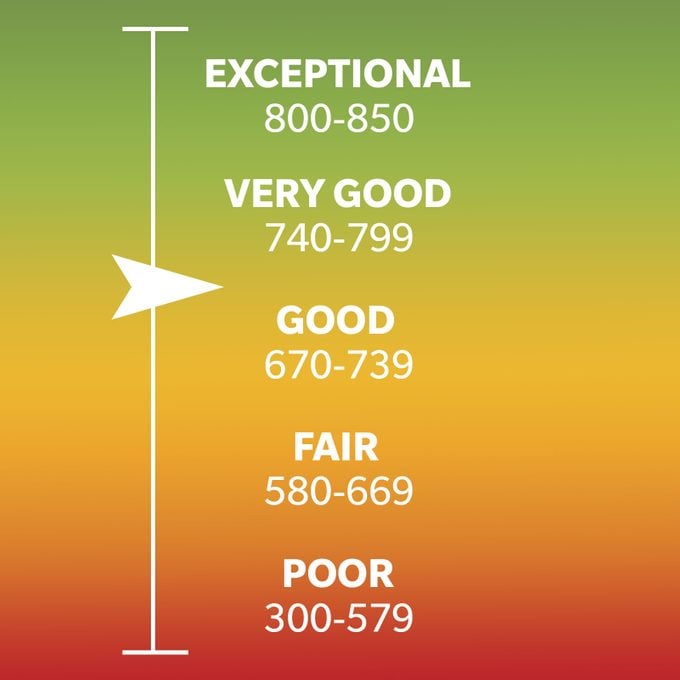What Is a Credit Score? The Secret Formula Behind That Magic Number
Updated: Nov. 27, 2022
What you pay for a house, a car, clothes, even groceries, will likely depend on three digits you probably don't even know. Your credit score, explained.
You know your Social Security number, your PIN, an access code here, a password there. But do you know the number that will cost—or save—you thousands of dollars? Your credit score is a number that banks use to determine whether you qualify for credit—and if so, how much interest they’ll charge you. Insurance carriers and phone companies rely on the scores to decide if you’re a good credit risk. A prospective boss or landlord may turn you down if your score doesn’t measure up.

Torrey Shannon and her husband, Dan, filed for bankruptcy in 2002. “We’ve cleaned up our act,” she says, “but if you look at our scores, you’d assume we’re deadbeats. Not a day goes by that it doesn’t affect us. We weren’t able to get a home until 2012.”
How your score is calculated may seem mysterious, but it’s essential to know your number and how to make it work for you. Try these ways to improve your credit score.
Q: What is a credit score?
A: Your credit score represents your creditworthiness: how likely you will pay your bills and pay them on time.
The Minneapolis-based Fair Isaac Corporation (better known as FICO) was the first to boil down your credit history, a detailed report on how you borrow and repay your debts, into a single three-digit number.
The FICO scale ranges from a low 300 to a high 850. The higher your score, the more likely you will qualify for the lowest interest rates. FICO gives its formula to the three credit bureaus—Equifax, Experian, and TransUnion—and they apply the math to your credit reports. Each pulls information from a slightly different network of lenders to compile its own report on you. (FICO earns a small royalty for each score the bureaus sell to lenders.) Because of this, you actually have three FICO scores, one from each of the bureaus, and they can vary by as many as 50 points.
You are entitled to one free credit report from each of the bureaus once a year to understand your credit score. You can get the FICO scores based on your TransUnion and Equifax credit reports from myfico.com for $15.95 each. Experian no longer sells its FICO scores to individuals.
Q: What is a perfect credit score?
This question is a little bit complicated. While a technically perfect credit score exists, actually getting one is often unrealistic. Under the FICO score model, the highest possible score you could get is 850 points. According to Experian, 1.2 percent of all FICO scores are at 850. But do you really need to worry about getting that high? Definitely not.
Q: What is considered a good credit score?
Since “perfect” isn’t a very realistic goal, what is a good credit score anyway? A good score ranges from 670-739. Anything between 740 and 799 is considered “Very Good” and anything 800 and above is considered “Excellent”. On the other side of good are two more categories. 580-669 is considered “Fair” and anything below 580 is considered a “Poor Credit Score.”
Q: How is your score calculated?
A: Your score reflects how well you’ve managed your debt. Black marks such as late payments remain on your record for seven years. (For some forms of bankruptcy, it’s ten years.) There are factors that don’t affect your score: employment status, income, debit card habits, savings, bounced checks, overdraft fees, utility bills, and late rent (if the issue hasn’t gone to court). Credit score calculations can get complicated, and there are some myths about what will hurt your credit score, but actually don’t.
Here’s what the bureaus use to calculate your score.
Payment history (35 percent)
The lowdown: The bureaus factor in when you last paid an account late, how often you pay late, and by how many days.
The strategy: Set up automatic payments to guarantee you’re never late. If you have a 760 FICO score, for example, you could probably qualify for a 4.9 percent mortgage. Drop 100 points (after one skipped or late credit card payment) and you’d be lucky to get 5.5 percent. Pay bills on time and you’ll improve your score within months.
Total debt (30 percent)
The lowdown: In general, higher debt loads work against you.
The strategy: Lenders look at your “usage ratio”—how much debt you owe on your credit cards compared with the total amount you could borrow. To keep your ratio low, don’t max out your cards, and don’t cancel cards you don’t use.
Say you owe $100 apiece on five credit cards, each of which would let you borrow up to $1,000. Your overall usage ratio—debt ($500) divided by credit limit ($5,000)—is 10 percent. Cancel all but one card and your debt is still $500, but your available credit drops to $1,000. Your usage ratio is now 50 percent, enough to lower your score. A lot.
The people with the best scores tend to use no more than 9 percent of their available credit. Go above 50 percent, and your score is headed for a nosedive, says Steve Bucci of MMI Financial Education Foundation, a credit-counseling firm. This can cause your credit score meaning to get a lot more complicated.
Duration (15 percent)
The lowdown: The longer you’ve had an account, the better. A late payment on a two-year-old account will hurt your credit score more than if you’d had the card for two decades.
The strategy: Avoid opening new accounts unless necessary, and keep your oldest credit cards active (assuming you pay any new charges in full). “In this environment, if you don’t use a card, you lose it,” says Frank Remund of Seattle’s Credit IQ, a fee-only financial advisory firm. “To demonstrate you’re still using the card, sign up to have it automatically make one utility payment every month.”
New credit (10 percent)
The lowdown: Multiple requests for credit mean you’re a greater risk. FICO looks at the number of new accounts that you have opened as well as the number of requests, or inquiries (there are two kinds), for your credit score or report.
The strategy: “Hard” inquiries—when you actually apply for new credit—can ding your score. The best way to protect yourself is to squeeze your applications—whether for a mortgage or a car or student loan—into the same 45-day period so they’ll count as a single inquiry.
Nowadays, banks and insurance companies routinely check account holders’ credit reports. If your score has dropped, they might increase your interest rate, reduce your credit limit, or cancel your card. (As of February 22, 2010, credit card companies will no longer be able to raise your rate on old balances if you have a fixed-rate card.)
“Soft” inquiries don’t count against you. For example: requests you make for your own credit report and those “preapproved” card offers that arrive, unsolicited, in the mail.
These are the 10 times you should never ever use your credit card for payment.
Types of credit (10 percent)
The lowdown: FICO looks at the number and “quality” of each type of account. For instance, a credit card from a national bank carries more weight than one from a department store.
The strategy: Revolving accounts (credit cards) tend to count more than installment loans (mortgages, car loans, student loans) because they’re better predictors of your debt management. If your mix of debt is considered “off balance,” it can hurt you. For example, it’s possible to have too many credit cards but not enough of other types of loans (four or five cards is probably okay, says Adam Jusko of indexcreditcards.com, depending on how long you’ve had them).
Q: Can you improve your score?
A: If you’ve made mistakes, get back on track as soon as possible, says Careen Foster, director of scoring product management at FICO. “The longer you wait, the longer it takes to improve your scores.” In today’s brave new world of tighter credit standards, you need at least a 700 to qualify for a card you once could have gotten with a 600, says Adam Jusko.
Get the real free
Check all three of your credit reports at annualcreditreport.com, the only site authorized by federal law. This will help you better understand your credit score meaning. Don’t be fooled by wacky commercials and computer ads for other “free” sites. You get one free report per bureau per year; pull a different one every four months to catch problems sooner.
Check for mistakes
Are there accounts you don’t recognize, names that aren’t yours, addresses where you’ve never lived, an incorrect birth date or Social Security number, inaccurate reporting of delinquencies? Has anyone stolen your identity? Have the bureaus combined your information with that of someone with a similar name?
Report errors
Laura Curley, who runs a charitable foundation in Chicago, was shopping with her husband, Dan, for an equity line of credit when they discovered that a disgruntled customer service rep had reported Dan as deceased on their mortgage file, a “fact” picked up by all three credit bureaus. “As a result,” says Laura, “my credit scores were in the 780s. My husband’s were zero. Official inquiries got the situation remedied.”
One study found that 79 percent of all credit reports had mistakes; one in four contained errors serious enough to have a significant negative impact on scores. Report errors to the appropriate credit bureau. It has 30 days to investigate and respond. Singletons, you’ll definitely want to make sure your score is accurate.
Don’t get flipped
Say you owe $1,000 on a revolving account and have a limit of $5,000. The bank might mistakenly say you owe $5,000 and have exceeded your limit of $1,000 four times over. New York City consumer advocate Mathew Sheldon says his score had dropped to 620 before he realized one of the card companies was improperly reporting the numbers. He got it fixed, he says, and he’s back up to 730. If this happens to you, write to the consumer reporting company and the creditor that provided the information, detailing the inaccuracy.
Time your inquiries
You don’t actually have a “permanent” credit report. All you have is some numbers stored in a computer file that changes constantly as lenders send in updates. If a bank asks for your score the day before you pay your credit card bills, it will get a different number than it would a few days later.
If you’re in a hurry to get a loan and your report doesn’t show recent transactions (paying off a balance, for example), ask your mortgage broker to get a “rapid rescore.” This will ensure that the lender sees you at your best, but it costs about $30 to $90 per account. If you can wait a month, your report will update automatically.
DIY improvements
You don’t need to pay “experts” to improve your score. You don’t need to pay $15.95 a month for credit monitoring services. And you don’t need to pay “dispute mills” to argue against every black mark on your credit report. “These companies don’t tell you that a negative factor might disappear for a while because the lender didn’t respond to a letter in 30 days,” says Candy Marshall of Suite Solutions, in Los Alamitos, California, which sells credit reports to bankruptcy lawyers. “But if it really belongs on your report, it will just reappear in a month, when the lender reports to the credit bureau again.”
Your best strategy: Improve your financial habits so your score goes up and stays up.
Better score, cheaper house
If a family put a 3.5 percent down payment on a $172,900 four-bedroom house in Greenville, South Carolina, they would take out a loan for $166,850. Here’s what their true bottom line would look like.
Score Rate Payment Cost
760+ 4.981% $893.75 $326,900
700–759 5.203 $916.50 $335,090
680–699 5.380 $934.83 $341,689
660–679 5.594 $957.22 $349,749
640–659 6.024 $1,002.93 $366,205
620–639 6.570 $1,062.30 $387,578
Less than 620: It will be tough to get a loan at all.
Better score, cheaper car
A buyer puts $3,000 down on a $25,605 2009 Honda Accord EX-L sedan and finances the rest over 60 months. Here’s his true bottom line.
Score Rate Payment Cost
720+ 6.42% $441.45 $29,487
690–719 7.88 $457.05 $30,423
660–689 9.86 $478.73 $31,724
620–659 12.79 $511.91 $33,715
590–619 17.64 $569.60 $37,176
500–589 18.43 $579.32 $37,759
Less than 500: It will be tough to get a loan at all.
What’s your score?
Print this quiz for a quick estimate of how lenders are likely to rate your credit.





